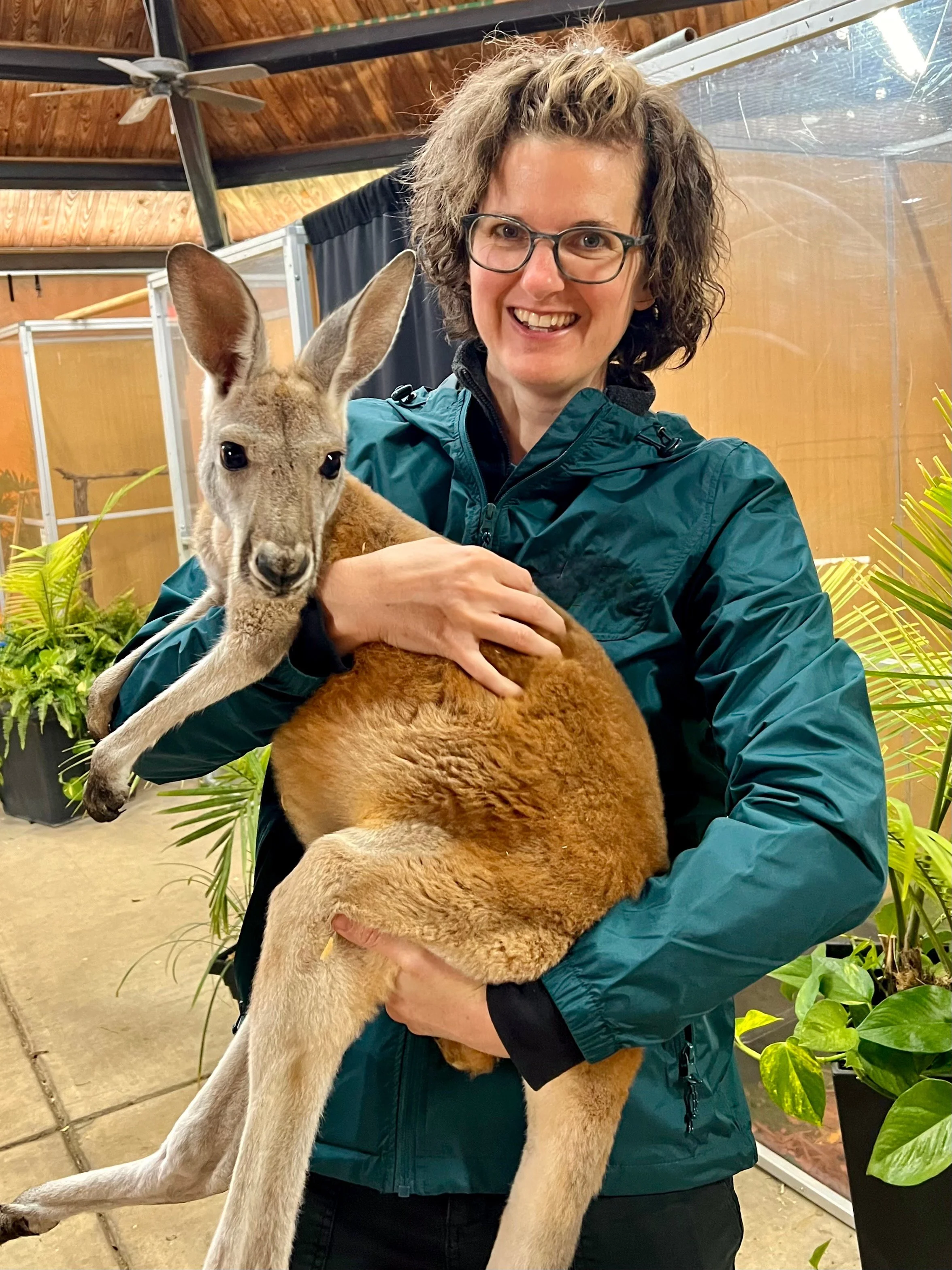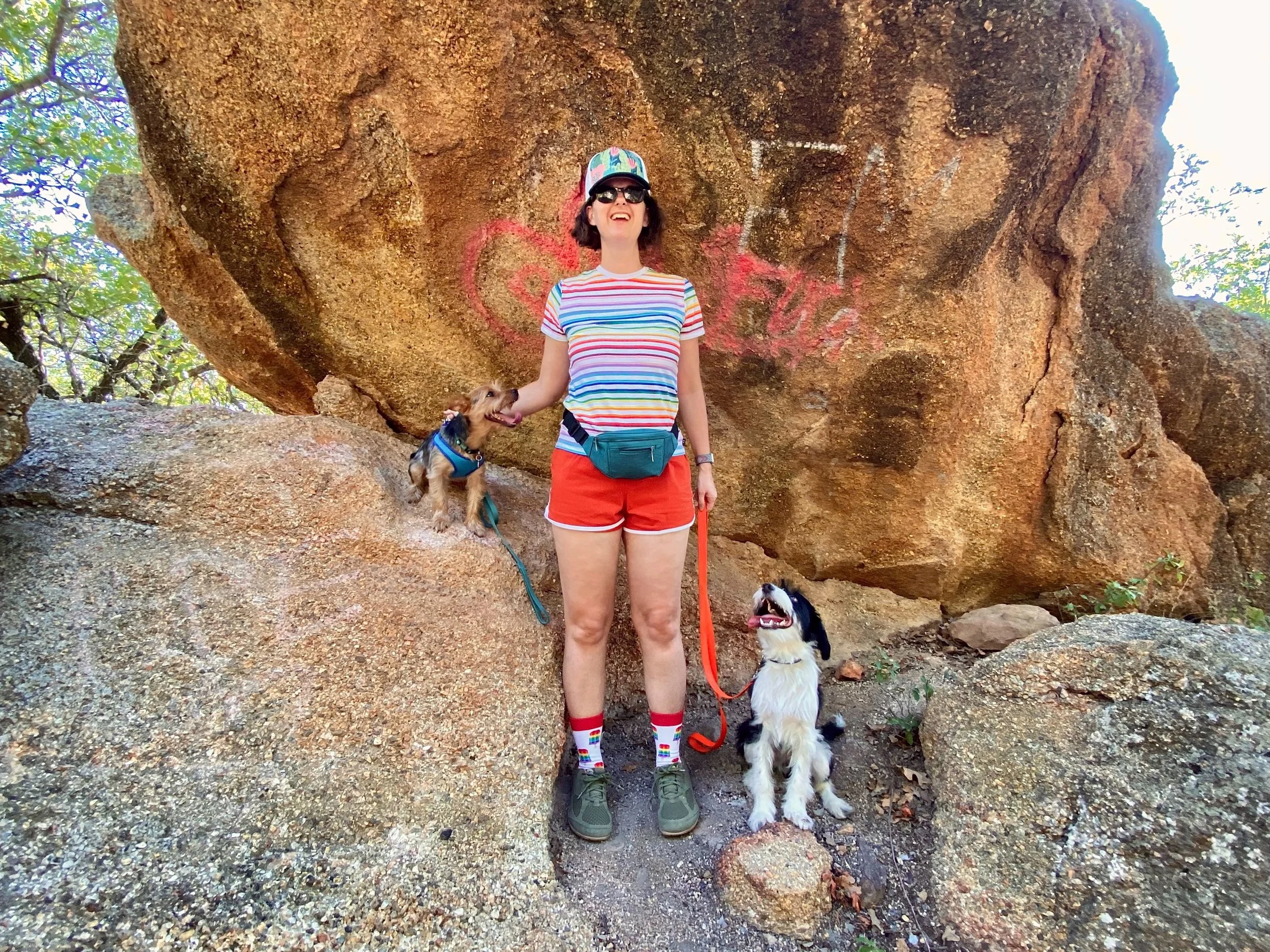Once upon a time my housemate asked me if I wanted to join her in hanging ancestral photos in the house. I declined.
I have a very vivid imagination. My ancestors, friends… everyone lives in vivid mindscapes. It’s like having a bunch of channels I can tune into at any moment.
I can see my great-grandmother washing laundry with her old tub and wringer on the back porch, or tending her garden - still growing next to the house today. Though she died 15 years before my birth, I know her through stories. I can see beloved friends, several states away watching movies, working in the garden, or riding horses and motorcycles.
As long as there are no still photos about, they thrive in my mind and I can spend time with them there.
There are, however, a few portraits dotted about my home: a beloved snail and dog, both now passed on, and 3 portraits of myself as a kid. I’m thinking of them now bc there’s a fourth that will be added to them, one taken today holding a kangaroo - the joy on my face is unmistakable.
* * *
I struggled with anxiety all the years of my lived memory. Depression first started settling in around age 11. (That seems so young to me now - to be carrying such a load. I feel for that sweet, scared girl).
Left untreated, they grew, slowly at first, then more quickly. I sought help as best I knew how, but it wasn’t enough, and as it started escalating, I found myself in the darkest place I’ve ever been in (and hope never to return). Thankfully, I finally found the right combination of professionals to support me and I’ve been working my way back ever since.
There are two metrics here. Mental wellness is one, mental stability another. Because I went well past the mark of mental wellness into un-wellness - all the way to mental instability - mental wellness is no longer the only metric I monitor. The decades I spent doing my best to get by consisted of sporadic mental-wellness, culminating in sustained unwellness until mental stability itself gave way. The illusion of mental stability is no longer a “given” to me. That illusion was completely and irrevocably broken.
Through all of this - a lifetime of untreated anxiety and decades of intermittent depression - I was also living with undiagnosed neurodivergence that was impacting my life in ways I couldn’t begin to understand.
I will be managing all of these things - anxiety, depression, and neurodivergence - for the rest of my life. The difference is that now I have the right tools and information.
I will also likely spend the rest of my life managing the side-effects of so many years without adequate knowledge and support.
My nervous system and digestive system acutely feel the fallout of all the untreated years. I better understand nervous system dysregulation, and I’m learning how to reconnect with my body and its cues after decades of dissociation from it. I [mostly] eat in ways to support a digestion that’s always been somewhat delicate, but now also suffers from the long-term effects of untreated, chronic anxiety. I wonder if I’ll ever feel “whole” again and I have to make peace with it in case the fallout is permanent.
I practice noticing my thought patterns all the time, working to challenge unhealthy scripts and rewriting neural pathways in my brain. Yet I still have a really hard time seeing myself, connecting with myself, and separating my actual self (who is awesome and worthy of love) from all of the competing voices in my head that would tear me down instead.
* * *
That’s why I keep pictures of me around my studio and on my phone. The kid pictures remind me to be kind and gentle with myself. It’s hard to be mean to that precious kid that I have so much empathy for. I remember her joy and excitement and I remember her fear and shame. It’s literally impossible for me to be mean to her.
I keep recent photos of myself around because they remind me of times when I was happy. They tether me to joy if clouds roll into my mind. (Conversely, I avoid - and have at times outright deleted - photos of me during the Hardest Years and the Dark Months, bc it’s too transportive. I was terribly underweight because anxiety prevented me from eating much of anything, my smiles are small, and I look distant - haunted or hollow sometimes even.
But the pictures now show full, round cheeks and curves on my body - things I’m still getting used to. I lived in the underweight body for 4 years. Though it scared me at first because I lost the weight so fast, I grew used to it. I learned to feel comfortable in it. Though the photos now admittedly look too thin in retrospect, I felt pretty… because our culture rewards super f***ed up beauty ideals for women. Two years in, and I still work to accept my full cheeks and fuller body. And I still harbor a desire to lose at least some of the weight. My relationship with my body is always a work in progress.
But despite that dissonance, what is undeniable is that I see joy in photos of me now - true, radiant happiness in my eyes. The hollowness of body and spirit are gone and replaced with a fullness of life and joy. I keep these photos around to remind me of how far I’ve come, how much work and support it took to get there, and that each of those captured moments were real and I can trust them. If I dip into a melancholy moment or season, I can look to that evidence and know the sun will come out again and shine from within me.
* * *
Isn’t that something? I can spend time observing ancestral family members that I’ve never met, and friends near and far away, but I can’t see my own self. I need visual reminders to be kind, gentle, and playful with my inner child and to remember that when clouds roll in, health, vibrance, and joy can and will come again.
Without these reminders I get lost. I get lost in the old scripts - the mean ones that keep me so, so down and breed insecurity and smallness and suffering. But with these photos around, I can better stay on course and keep moving every day in ways that support wholeness, health, and peace (or at least neutrality when those feel like too much of a reach). These photos of myself are my map. Without them I would be lost.
* * *
It’s not been an easy road, but it’s one I can finally say I’m proud of.
I’m proud because I faced my demons every day for decades without adequate support and treatment. I kept living even when life felt like way too much. I am a survivor.
I’m proud because I take supportive steps daily, weekly, and monthly to keep me oriented towards healing and wellness. I show up. I do the work. I listen to others, learn, and practice.
I’m proud because I share my experiences with others. When I reframe my past as experience that can help others who are struggling, it helps ease the sorrow and regrets I feel about 40-ish years of Really Hard Stuff that I wasn’t equipped to deal with myself.
I am a survivor, an advocate, an educator, and a supporter and I feel dang good at it because I’ve learned it all in the trenches of life: what to do, what not to do, how to survive, and how to plot a course to recovery and then practice recovery and wellness every day.














